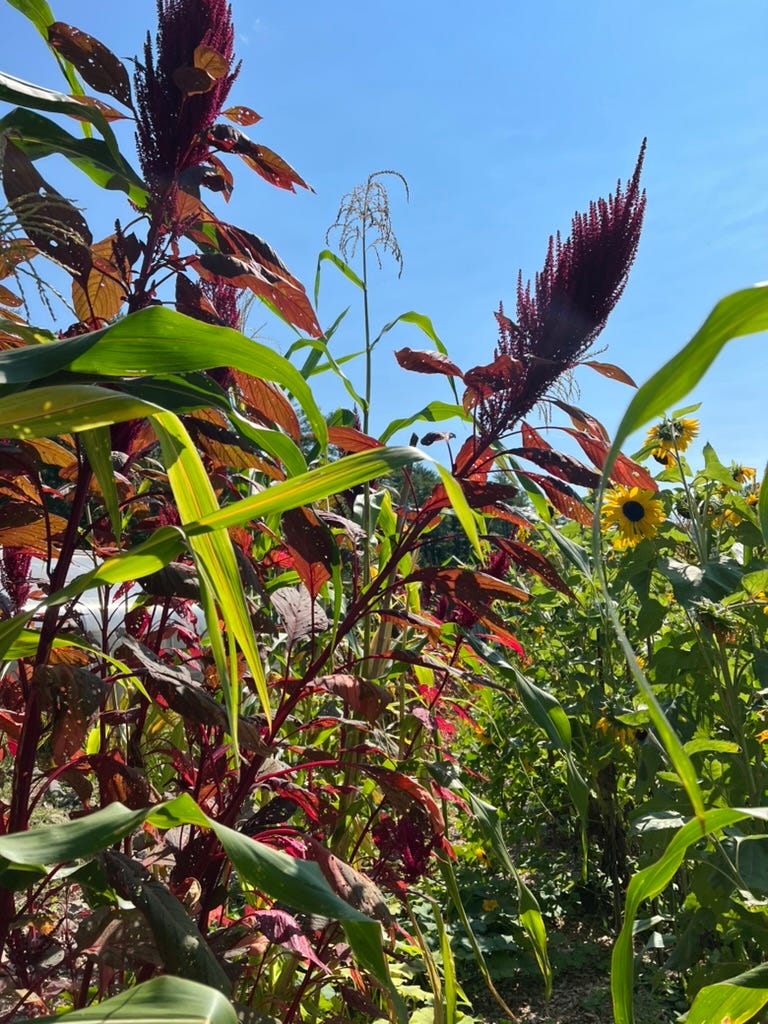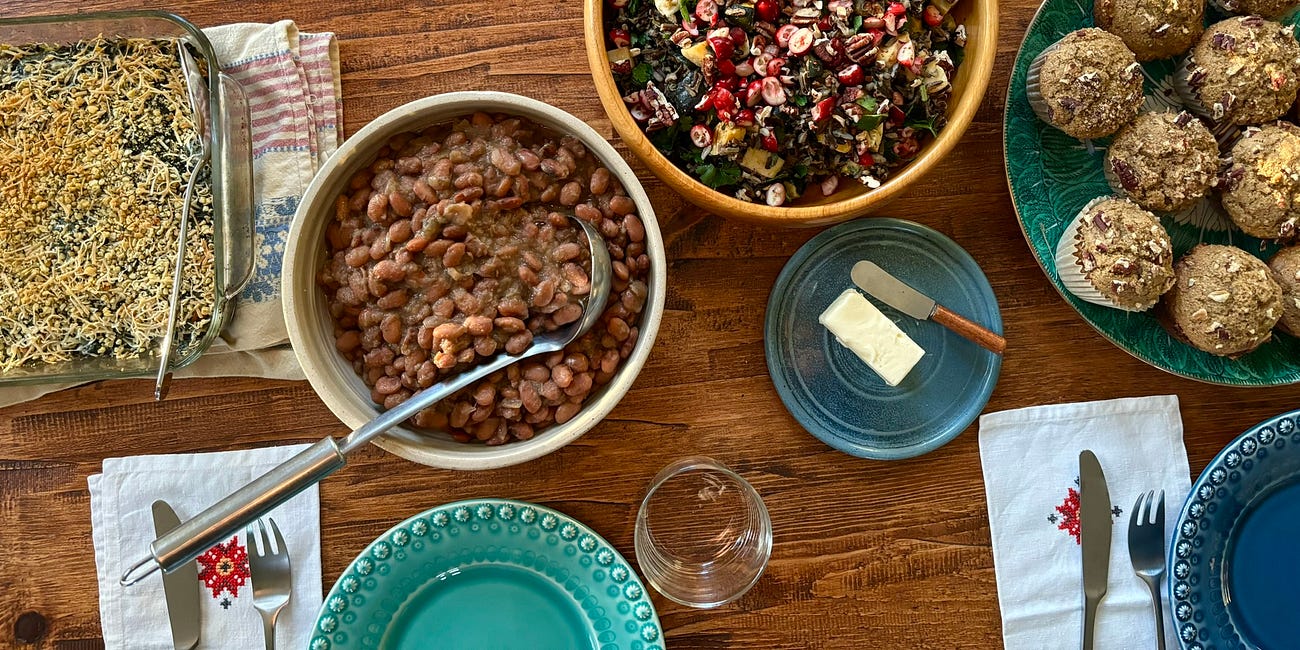October is breathtaking at the monastery garden. Red amaranth and blue corn sway seven feet above the ground, and orange-yellow sunflowers and marigolds fill in beneath. I visit every Wednesday to weed or harvest, and even plant some late-season bok choy seedlings. When I snip a collard leaf or carefully remove a whole head of lettuce I feel like I’m in a movie. That perfect lettuce might be a set piece purchased from Whole Foods, except that I saw it here last week, a little smaller. It still shocks me in some primal way that planting seeds leads to vegetables, which become the lunch I’m served with everybody else after work practice. It’s both easier and more laborious than I imagined to grow food: planting a seed happens so quickly, but all the work around planting — the weeding and pruning and hoeing and preparing of beds — is so much.
When I presented myself to the head gardener Shindo at the beginning of September, it was like Arthur to Merlin or Luke to Yoda; gardening was a totally dark art to me. We had moved recently and I was already roundly pregnant, too late to start a new job, so I decided to spend the fall learning to garden. The Zen monastery in Mt. Tremper is a place I’ve come for years for retreats and community, and I’d always admired the small, tidy garden that produced so much of the food served to the residents. They welcomed me to come work in the mornings and then to share lunch afterwards.
I had a lot to learn. Our new house had a yard with several overgrown raised beds, but at first I was afraid to touch them. How do I know what are weeds and what is intentional? I kept wondering. After my first day under Shindo’s tutelage, I had my answer: They are all probably weeds. I went home and tore up the beds. The next week, Shindo had me planting crimson clover in an unused bed, because it would add nitrogen into the soil. I did the same thing in my yard. Each week, I did something small and mundane that, for me, provided new information. After Halloween, I planted garlic, and was amazed to learn that all it took was to dig a hole (about four inches deep), place a clove in the center with the pointy end up, and cover it up. I’ve planted garlic at home now, but I won’t know for months whether any of them will take.
No one in my family gardens, and aside from the indestructible mint patch that conquered one side of my childhood house, I never had the experience of growing something that could be eaten. It was a long time before I made any connection between food and the seasons. I think it started with tomatoes. I read something in a cookbook or article about how a chef never served winter tomatoes, and it was only then that I began to consider the difference. I started shopping at the farmer’s market near my apartment in Brooklyn because I could get the good bread there and gradually, so gradually, as I tasted grapes in the fall and berries in the spring, I started to piece together a temporal map of food in the northeast region I’d lived in all my life.
It’s easy to live and cook today in a culinary sphere that’s as shielded from the time and weather as a fluorescent-lit Walmart strives to be: the same anytime, anywhere. There are crisp bags of baby spinach and packages of strawberries on the shelves year-round. The only way to know what time of year it is in most supermarkets is by the end-cap displays of pumpkin spice muffin mix or M&M-filled plastic candy canes. It occurs to me that our cultural fixation on Starbucks holiday drinks might be our replacement for seasonal scarcity — maybe we don’t really want the same thing anywhere anytime.
What happens when the earth has ceased to be our clock? Our own schedules, calendars, political cycles take precedence, feel like the only thing that’s real. Unbound by seasons, unbowed to nature, we pursue control. Our power over the world feels like safety, until it’s not.
Pregnancy reminds me that our bodies serve rhythms we did not invent. Nine months, three seasons, a long incomprehensible germination in the dark. I am not creating the baby in the way that I create this essay, but according to mechanisms of creation that I don’t understand and don’t need to. I’m a garden. I’m a bed. As my belly grows by centimeters (one per week of pregnancy, the metric system being apparently that tightly coupled to the human body), I am a clock. I must submit to my own ticking. I’m impatient with the nuisance of pregnancy, but my feelings don’t change my body’s plan.
As daylight savings time passes by, I feel winter coming in a way I never did in the city. The afternoon sunset is more visible when the streets are not full of light, and we seem to eat dinner earlier and earlier through November. Everything I cook is a stew: chickpea cashew korma, Japanese curry with tempeh, Brazilian moqueca, split pea soup. It’s all too brown to post to Instagram. There are no more berries for Miro but he seems perfectly content with apples and pears. I bake some of the apples with butter or nut butter and cinnamon and we eat them with yogurt. I cook squash in a million different ways and though I get tired of pushing my biggest knife through their skins, I find that sage-dressed acorn squash and caramelized pumpkin slices and sweet potato sesame bread are distinct enough that I don’t tire of the vegetable.
My last visit to the garden is shortly before Thanksgiving. There isn’t much to do. I pull up the remainders of some flowers and then cover the beds with straw. I spend the rest of my shift sitting at a picnic table in the sunlight, stripping dried tulsi and nettles from their stalks to crush together in a big bag for winter tea. The garden looks so orderly now with its rows of straw-covered humps, in comparison to the riotous beauty just a month ago. The roar of bees and birds has given way to the occasional scrabble of a vole, whom Shindo said like to get busy around this time of year. The mountains are just there now, large and dramatic, but without the blaze of color that makes you unable to look away.
There’s a calmness about the world as the days shrink to their shortest length. We’ll have the new baby soon, right around New Years. I’m trying to let the earth pull me into the rhythm of deep interiority that a newborn demands. There will be the waking and feeding through nights that creep into early mornings and the sense of being cut adrift from the schedule of the working world. This year, I welcome the darkness and quiet of the winter. There’s no need to fill it with light and sound.
I was at the monastery on the day summer ended. It was the middle of a weeklong silent retreat in October of which every day had been sunny and mild. In the evening, I walked up the mountain some ways to the pond where the birds and deer like to come, and sat on a rock to watch. A strong wind blew in. I saw it before I felt it — treetops far off begin to shiver, and the shivering came closer and closer like a wave until it broke at the edge of the pond in a burst of leaves. They whipped around me, pulled me to standing on my rock. I opened my mouth and the wind became my breath.
What I’m Cooking
Thanksgiving Meal + Recipe For Wild Rice Salad (v, gf)
I had our neighbors over for dinner (finally! It took me months to get settled enough) and made a spread that could easily be a Thanksgiving dinner. We started with amaranth crackers with cheese and fruit, the main course included smoky beans, baked spinach, sorghum corn muffins, and wild rice salad with acorn squash, tofu, halloumi, and fried sage. Instead of pie for dessert, I made Melek Erdal’s recent




